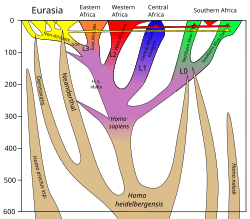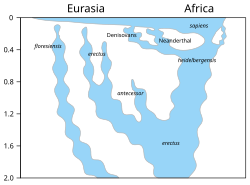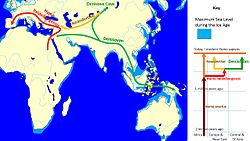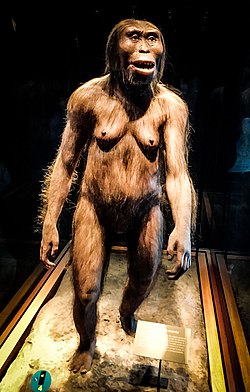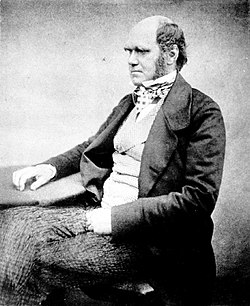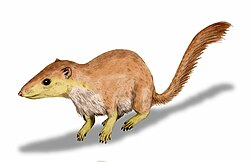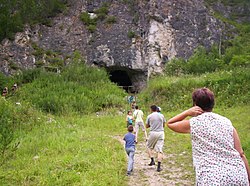Homo lineage 2017update
The following features are based on Stringer (2012).
- H. heidelbergensis is shown as the link between Neanderthals, Denosiovans and H. sapiens
- Division of Asian H. erectus into Java Man and Peking Man
- H. antecessor shown as a branch of H. erectus reaching Europe
- After H. sapiens emerge from Africa some 60 kya they spread across the globe and interbred with other descendants of H. heidelbergensis, and Neanderthals, Denisovans
Modifications based on other publications:
- H. floresiensis in Springer is incertae sedis, it is here shown as a branch of Asian H. erectus extinct some 50 kya; this seems to be the emerging consensus as of 2016; e.g. van den Bergh, G. D. et al. (2016-06-08). "Homo floresiensis-like fossils from the early Middle Pleistocene of Flores". Nature. 534 (7606): 245–248. doi:10.1038/nature17999.
- multiple admixture events to Sub-Saharan African populations:
- archaic admixture to hunter-gatherer groups (Biaka Pygmies and San), with a separation time of some 700kya: Hammer et al. (2011). "Genetic evidence for archaic admixture in Africa" (PDF). Proceedings of the National Academy of Sciences. 108 (37): 15123–15128. doi:10.1073/pnas.1109300108.
- archaic admixture to hunter-gatherer groups (Pygmies, Hadza and Sandawe) with a separation time of 1.2 Mya: Lachance, J. et al. (2012). "Evolutionary History and Adaptation from High-Coverage Whole-Genome Sequences of Diverse African Hunter-Gatherers". Cell. 150 (3): 457–469. doi:10.1016/j.cell.2012.07.009. PMC 3426505 Freely accessible. PMID 22840920.
- archaic admixture to West African agricultural populations (Mende and Yoruba): Xu, D. et al. (2017). "Archaic Hominin Introgression in Africa Contributes to Functional Salivary MUC7 Genetic Variation". Molecular Biology and Evolution. 34 (10): 2704–2715.
- more articulation is shown for H. erectus in Africa, including a sub-branch leading to H. naledi, which as of 2017 has been dated to about 330-230 kya. Dirks, Paul H.G.M.; Roberts, Eric M.; et al. (9 May 2017). "The age of Homo naledi and associated sediments in the Rising Star Cave, South Africa". eLife. 6: e24231. doi:10.7554/eLife.24231 Freely accessible.
- H. erectus is shown as emerging from H. habilis some 1.8 Mya; H. habilis is shown as persisting in Africa alongside H. erectus until about 1.5 Mya.
- late survival of robust australopithecines (Paranthropus) until about 1.2 Mya is indicated in purple.
Relevantní obrázky
Relevantní články
DenisovanéDenisované jsou vyhynulí příslušníci rodu Homo, blízcí neandertálcům. Bylo nalezeno pouze několik zlomků jejich kostí, první z nich v roce 2008 v Denisově jeskyni na Altaji v Rusku. Stáří bylo určeno na 41 000 let. Přesto bylo možné provést molekulární analýzu mitochondriální DNA (mtDNA), která denisovany identifikovala jako odlišnou vývojovou větev. .. pokračovat ve čtení
ČlověkČlověk (Homo) je rod živočichů z čeledi hominidi (Hominidae), k němuž patří jediný současně žijící zástupce člověka – druh člověk moudrý a jeho blízcí vyhynulí příbuzní. Odhaduje se, že rod je asi 2,8 milionu let starý. Vznik rodu Homo se datuje do stejné doby, kdy se také objevují první kamenné nástroje, a tedy v době, kdy začíná nejstarší paleolit. .. pokračovat ve čtení
Evoluce člověkaEvoluce člověka (antropogeneze), tedy proces, který podle evoluční teorie vedl ke vzniku druhu Homo sapiens, se odehrál během dlouhého období kenozoika. Na jeho studiu se v současnosti podílí velké množství vědních oborů – vedle paleoantropologie je to například primatologie, geologie (stratigrafie), klimatologie nebo embryologie. V poznání mladších fází antropogeneze pomáhá také archeologie; velký posun v novější době umožnil rozvoj genetiky. .. pokračovat ve čtení

